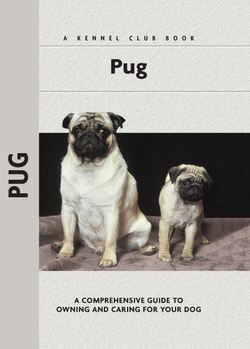Читать книгу Pug - Juliette Cunliffe - Страница 20
На сайте Литреса книга снята с продажи.
HEALTH CONSIDERATIONS
ОглавлениеBecause of the Pug’s short foreface, the breed can suffer breathing difficulties and does not easily tolerate extreme heat. In general, though, the Pug is a reasonably healthy breed and can live until a ripe old age. It is, however, worth bearing in mind that often Pugs do not take well to anesthesia, so it is important to mention this to your vet if an operation is pending.
Pugs, like other short-nosed (brachycephalic) breeds, can be prone to elongation of the soft palate. The Pug has been bred for centuries to have a short nose and wrinkled skin; as a result, the soft palate tends to be wide and flabby. As the dog pants, the soft palate gets drawn back into the larynx so that air is unable to enter the lungs. It is this that causes Pugs to suffer distress in unusually hot weather or following exertion.
CORRECTIVE SURGERY
Surgery is often used to correct genetic bone diseases in dogs. Usually the problems present themselves early in the dog’s life and must be treated before bone growth stops.
It is therefore necessary to keep a very careful eye on your Pug in hot weather and always to be on the lookout for any sign of fatigue during exercise. Danger signs are protruding, staring eyes and the head’s being held high in an effort to draw in more air. A dog can lose consciousness and his breathing may stop, but sometimes will resume within only a few seconds, though not always.
It goes without saying that any dog can suffer distress and can die if left in a car on a warm day, even with ventilation. Pugs are even more likely to be affected than the majority of other breeds, so beware! Never leave your Pug in your car, and this tragedy will be avoided.
Should your dog be unfortunate enough to suffer from heat exhaustion, cold water or ice should be put on the head, face and body immediately; the dog should also be kept as cool and quiet as possible. Any Pug that seems particularly prone to the consequences of an elongated soft palate should certainly not be bred from.
Here it is worth mentioning that, whether or not your Pug has breathing problems, as with any other breed, food should never be given immediately before or following strenuous exercise. Opinions vary, but when exercising my own dogs I always like to allow one full hour’s rest before or after any meal.
DOGS, DOGS, GOOD FOR YOUR HEART!
People usually purchase dogs for companionship, but studies show that dogs can help to improve their owners’ health and level of activity, as well as lower a human’s risk of coronary heart disease. Without even realizing it, when a person puts time into exercising, grooming and feeding a dog, he also puts more time into his own personal health care. Dog owners establish more routine schedules for their dogs to follow, which can have positive effects on a their own health. Dogs also teach us patience, offer unconditional love and provide the joy of having a furry friend to pet!
A Pug should have eyes that are gloriously described as globular in shape, but they should not be too bulbous. This shape can bring with it various problems in that the eyes, being prominent, are more likely to be exposed to injury or to become damaged through dust and dirt becoming entrapped. Sensible Pug owners ensure that there are no rose bushes with thorns or any other spiky plants in their gardens.
At any sign of injury to the eye, veterinary attention should be sought, but, in an emergency, a couple of drops of very slightly warmed castor oil can be soothing. If a Pug has suffered a cold in the eye, the eye may be bathed either with warm milk or with cold tea. If ever a Pug’s eye is watering, this is a sign that something is amiss and the cause should be investigated without delay to avoid long-term damage.
Pigmentary keratitis, often indicated by the dog’s rubbing his eyes, can lead to blindness. The condition is linked to poor tear production, entropion and dry eye. Entropion involves one or more eyelids’ turning inward, so that they touch the eyeball. In consequence, this causes irritation to the cornea and can be painful. Entropion can involve in-turning eyelashes, but in a wrinkled breed such as the Pug, it can also occur in a mild form if a dog loses weight suddenly. At any sign of entropion, whatever the suspected cause, veterinary attention should be sought.
Luxating patella is a dislocation of the kneecap, caused because the kneecap of an affected dog has a shallow groove. This is a hereditary defect and is known in Pugs.
Another problem that has affected the Pug is one normally associated with larger breeds. This is hip dysplasia, in which the ball and socket joint of the hip fit badly, causing consequent lameness and discomfort. Fortunately, hip dysplasia is not now so prevalent in the breed as it was in earlier years. Dogs with poor hips or luxating patellas should not be used in breeding programs.
